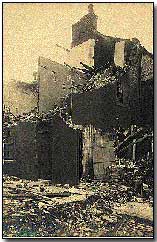Battles - Raid on Scarborough, Hartlepool and Whitby, 1914
 At approximately 8.10 on the morning of 16 December 1914 the First High Seas Fleet Scouting Group, commanded by Admiral
Franz von Hipper,
unleashed a bombardment of the North Sea English seaports of Hartlepool,
West Hartlepool, Whitby and Scarborough.
At approximately 8.10 on the morning of 16 December 1914 the First High Seas Fleet Scouting Group, commanded by Admiral
Franz von Hipper,
unleashed a bombardment of the North Sea English seaports of Hartlepool,
West Hartlepool, Whitby and Scarborough.
Lasting until around 9.30am the bombardment (of 1,150 shells) resulted in some 137 fatalities and 592 wounded. The two coastal defence batteries in Hartlepool (Heugh Battery and Lighthouse Battery) responded, firing 143 shells and damaging three German ships, including the heavy cruiser Blucher.
In spite of the inevitable outrage the incident raised among the British popular press and the public at large - which held the Royal Navy squarely to blame for failing to prevent the raid - the attack was viewed as legitimate in German naval quarters, with both Hartlepool and Scarborough deemed valid targets in light of their status as fortified towns.
The Royal Navy had in fact received advance warning of the raid by the naval intelligence unit (the so-called 'Room 40' group) and Admiral Warrender was despatched with a fleet of six battleships, four battlecruisers, four heavy cruisers, six light cruisers and eight submarines to intercept the German raiding force. The Commander-in-Chief of the Grand Fleet, Sir John Jellicoe, recommended attaching his force to provide backup to Warrender but this was not deemed necessary by the Admiralty.
However, while the raid was primarily conducted by Hipper and his force of five battlecruisers (Seydlitz, Moltke, von der Tann, Derrflinger and Blucher) plus accompanying light cruisers and destroyers, he was followed by the might of the German High Seas Fleet under Commander-in-Chief FredErich Ingenohl.
 During
the early morning of 16 December - prior to the attack - Warrender came
within view of Ingenohl's fleet but mistook the latter for a small raiding
force. Ingenohl in turn believed Warrender's force to be Jellicoe's
Grand Fleet.
During
the early morning of 16 December - prior to the attack - Warrender came
within view of Ingenohl's fleet but mistook the latter for a small raiding
force. Ingenohl in turn believed Warrender's force to be Jellicoe's
Grand Fleet.
Deciding caution to be the better virtue Ingenohl turned the High Seas Fleet around en route for home: he nevertheless ordered Hipper to press on with the attack, but omitted to warn him of the British sighting.
Setting off in pursuit of Ingenohl Warrender himself changed course when advised via radio of the start of a bombardment further north - Hipper had begun his raid. He therefore turned round and headed towards the north-sea coast; meanwhile eight pre-dreadnoughts set off from Rosyth and Jellicoe's Grand Fleet put off from Scapa Flow, effectively encircling Hipper's force.
In the event Hipper escaped immediate punishment for his action when an example of inefficient British signalling enabled him to evade Admiral David Beatty's four battlecruisers, attached to the Grand Fleet.
Amid widespread clamour for the Royal Navy to catch Hipper, the latter's decision to try and repeat his success in late January 1915 led to his interception at Dogger Bank on 24 January, where his squadron was defeated but managed to escape.
Click here to view a map of naval operations in 1914.
Photographs courtesy of Photos of the Great War website
"Harry Tate" was the nickname given by British pilots to the R.E.8 aircraft
- Did you know?
